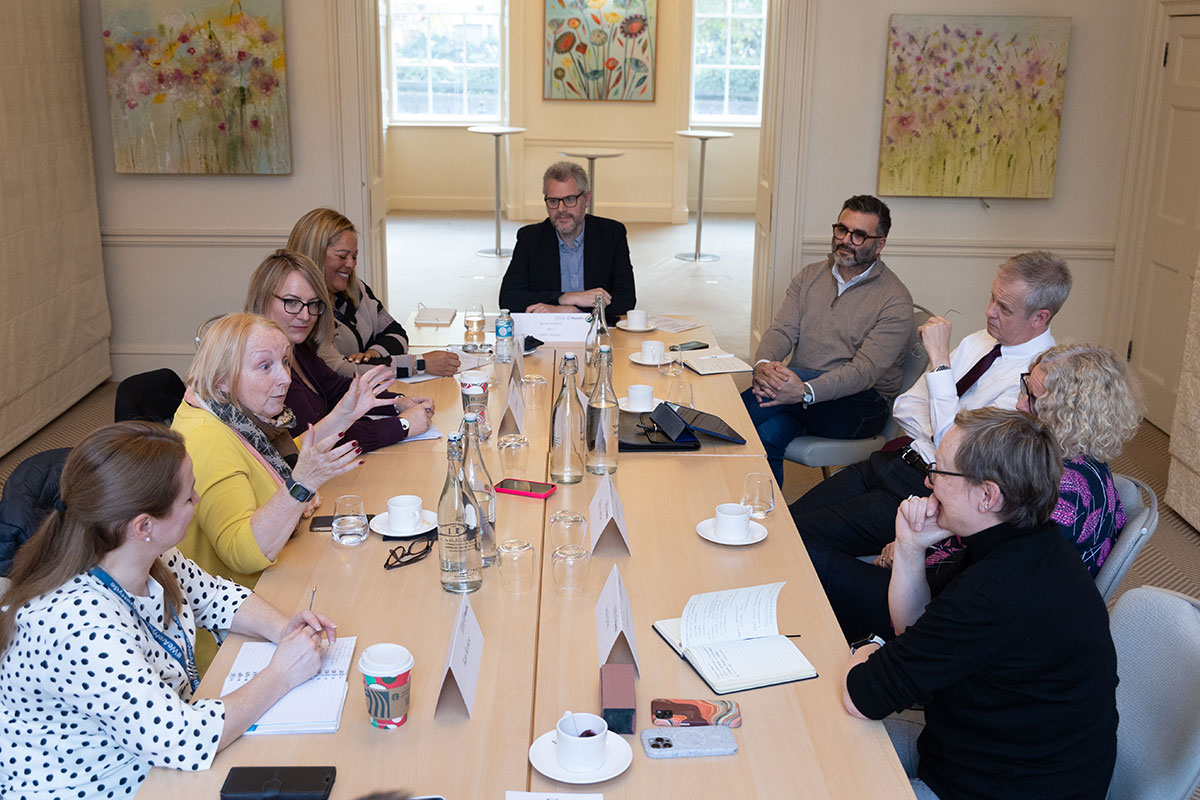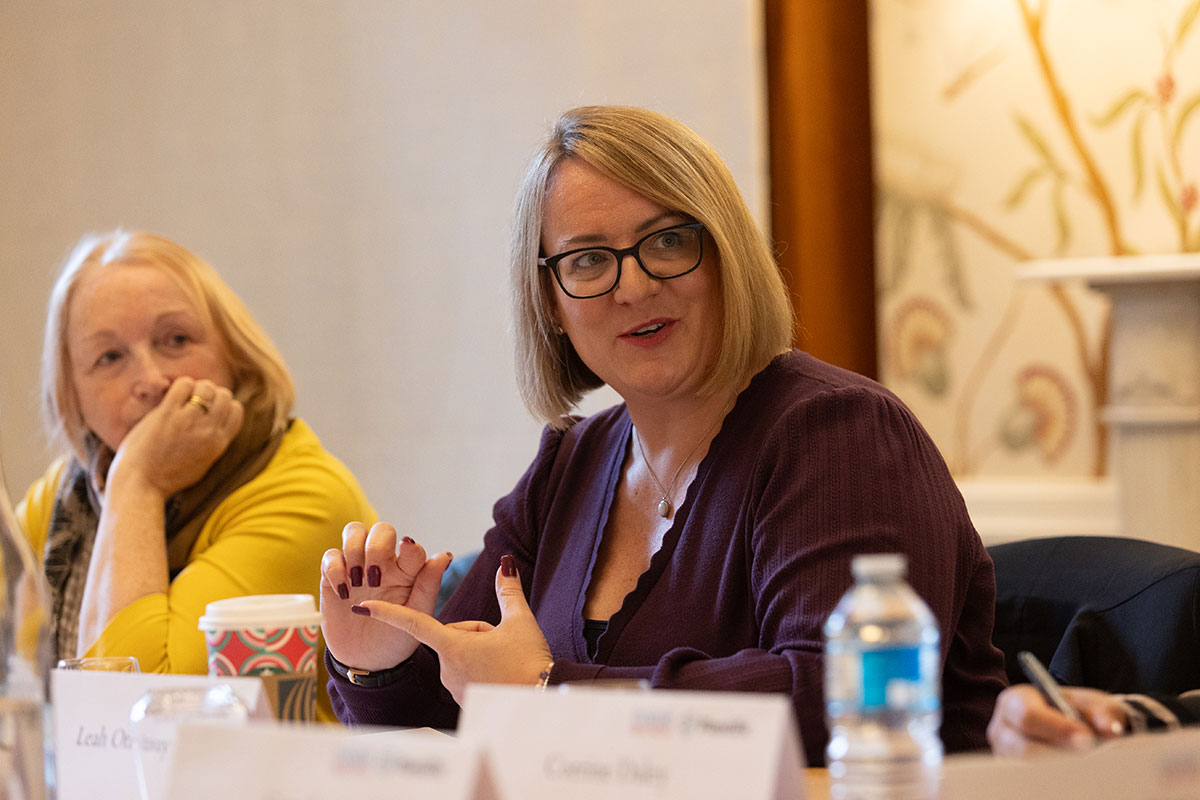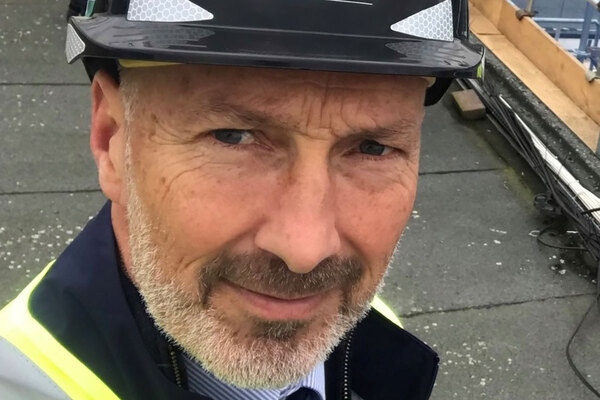How to make a tech transformation work
Landlords are grappling with how to make the most of digital tools that can improve efficiency and services. A group of leaders discuss ways of approaching it. Photography by Belinda Lawley
In association with:
![]()
Doing more with less is a mantra of increasing familiarity to the social housing sector. Housing providers are under increasing pressure from various fronts, all competing for precious resources.
The decarbonisation deadline ticks ever closer. The costs of energy and materials are rising. And against this backdrop, landlords continue to strive to improve the services they provide to the people they house.
The digital technology revolution has the potential to help meet these demands. It promises greater efficiency, improved service delivery and lower costs – by automating time-consuming manual tasks, for example, or generating operational efficiencies by gathering and analysing huge amounts of data. But transformation isn’t always easy; it is, almost by definition, disruptive.
As social landlords begin to integrate digital technology into their operations, they will need to bring residents and staff along with them on the journey. How can the sector ensure it gets this balance right? What do leaders need to consider to ensure they maximise this potentially transformative technology, while ensuring no one is left behind? Inside Housing, in association with maintenance and property management software provider Plentific, convened a gathering of sector leaders to discuss how to meet these challenges.

Getting the basics right
“We talk a lot about transformation in the sector when really we mean modernisation,” says Sarah Jones, chief executive of 54,000-home Anchor. “That can frighten people and make them anxious.”
Change is not a revolution, but a constant and incremental process, she adds. “When we’re approaching modernisation or transformation, we have to be clear that we’re doing it for the right reason, and we have to be clear about what that reason is. I use a phrase a lot about making sure we’re looking through the right end of the telescope. So when we’ve got a proposal coming forward, it’s not presented as, ‘I have this solution I want to implement.’ It’s, ‘I have a problem I want to solve,’ and we start from there.”
The Hyde Group is four years into a five-year digital transformation programme, says Kate Krokou, the 120,000-home association’s chief strategy and transformation officer. Hyde has learned a lot of lessons over that period, Ms Krokou says, but one stands out: digital systems are not, by themselves, going to fix any underlying issues.
“Where we really started to get traction [in the transformation programme] was when we looked at changing our processes, structures and the way we work,” Ms Krokou says. “Sticking systems on top of broken processes can lead to bad outcomes.”
Like Ms Jones, Leah Ottaway, director of people and organisation development at 109,600-home L&Q, is wary of the word “transformation”.
“I always use that word loosely,” Ms Ottaway says. “It’s about making sure that we’re delivering the best outcomes for our customers – and that’s going to be a continuous piece. It’s not that we transform the business and it’s done.”
From the top
Technology is a tool that can create unprecedented change, she adds, but it is only one piece of the puzzle. “How do we transform the culture alongside the technology and the processes that we’re using?” she asks. “It’s not just one thing in isolation. It’s everything wrapped up together.”
People are hardwired to resist change, Ms Ottaway adds. As humans, we prefer predictability – and successful organisational change is based on managing that tendency. Or, as Corrine Daley, director of repairs and estate services in London and East for Sovereign Network Group, puts it: “How do we make continuous improvement not feel like change to everyone?”
Leadership is a key part of the answer to that question. Successful digital transformations have several things in common, says Cem Savas, co-founder and chief executive of Plentific: “One is clear leadership from the CEO down, giving direction on what needs to be done, and being into the detail,” he says.
Chief executives might not be used to taking a details-oriented approach, Mr Savas adds, but it is important in this context. “I know that’s not easy… But if you’re talking about making a big change, the CEO needs to be giving direction to what they want to achieve, and [be] into the details. We see clients where CEOs are engaged and interested in being more successful in a shorter period of time than [CEOs who] manage it through other channels.”
Having a supportive and invested CEO is key to successful transformation programmes, agrees Vicky Lambert, director of business improvement and change at 29,000-home Gentoo Group. “But we also have a really great resource in our managers – they are critical to delivering any change,” she says. “We need to give our managers the skills, the information, the tools that they need to deliver change within the organisation… They’re the ones that will deliver the messages, the reasons, the case for change, directly to [their] teams. We don’t always train them to do that, but they are an untapped resource that we need to use more.”
Ms Ottaway says everyone in a company has a role to play. Everyone is an expert in their own field, and leaders should empower their staff to be able to suggest and make changes for the better. “What’s the individual’s role in continuous improvement?” says Ms Ottaway. “We all do a day job. We all see opportunities in our working week where we think actually that could have been done a bit better… Everyone in the organisation should be empowered to do that.”
Ultimately, the benefits of technology should make life better and easier for residents by delivering what Glenn Harris, chief executive of 35,000-home Midland Heart, describes as “quicker, more responsive [services], and better experiences that lead to better satisfaction”. So how can landlords ensure residents aren’t left behind?
Start by asking the right question, says Aileen Evans, chief executive of 13,000-home Grand Union Housing Group. “How do we understand our customers and what they want?” she asks. “What stuff impacts their daily lives that stops us delivering a great service?”
“If you talk to tenants, the number-one issue for them is repairs,” says Mr Harris. “Do it quickly, do it well and clear off, essentially. Second, they talk about anti-social behaviour, and the third thing is so far third, I can scarcely measure it.”
Efficient services
Technology has the potential to make repairs services more user-friendly and efficient – but web portals and mobile apps are not going to be to everyone’s taste. When Midland Heart introduced a mobile app for reporting and tracking repairs last year, take-up was limited. “About 15% of [repair requests] go through that route. We still find around 80-85% of the times when tenants want to interact with us, they tend to ring in,” says Mr Harris. “So the challenge is how you can keep multiple channels open and link up your tenants with your colleagues as well.”
Sometimes the answer is simple, says Ms Ottaway. Giving feedback on L&Q’s transformation programme, residents gave their approval, she says – but what they actually wanted from these changes was pretty simple. “I want to know who my neighbourhood housing lead is and when they’re not available, I want to know who my contact is, and when I have a complaint, I want to be kept informed,” Ms Ottaway says. “People want to be treated with respect and common decency… We all want that kind of same level of interaction. And sometimes we just have to appreciate that.”
People respond well to transparency, says Ms Jones. “Engagement is key, and we sometimes confuse engagement with communication. Engagement means you ask for responses back. Sometimes you won’t like them, and it means that you have to change your opinion, and you have to lean into that.”
Successful technological transformation has to be built on the right technology for the job. The first question to ask, Mr Harris from Midland Heart suggests, has to be: is your core system fit for purpose?
“Tackling that is hard,” he says. “I’ve been to see colleagues who spent millions on the customer relationship management [CRM] system that was going to transform everything – most are quite disappointed.”
Another issue to consider, he says, is the unnecessary accretion of technology. Organisations can end up bolting more systems onto their existing CRM hub – and this can end up making life harder, as Midland Heart discovered. “You start to get quite a complex landscape if you’re not careful,” Mr Harris says. “We’ve been working on bringing that down. We’ve got nine systems now. We used to have 26 or 27 a few years ago.”
Getting the pace of change right is also important. “Trying to design a perfect process from the start is never going to work,” says Ms Krokou from Hyde. “You’ll spend 20 years building it, and it will be obsolete by the time it’s ready.”
Instead, she cautions, don’t let perfect be the enemy of good. “We were trying to boil the ocean in the early days,” Ms Krokou adds. “We had to say, let’s just start somewhere. It won’t be perfect… We’ll roll out functionality as we go – get a minimum viable product out, test it, get it working. That builds momentum.”

Organisations also need to ensure they have the right skills in place to integrate new technologies. “What skills do we have, and what skills do we need for the future in key strategic roles that will unlock things for customers and take people forward?” Ms Ottaway asks. L&Q, she says, is talking about creating a “skills taxonomy”.
“So looking at some of those strategic roles [and] aligning that to our transformation programmes,” she explains. “So thinking about: where do we need to get to? Where are we now?”
It is a really interesting idea, Ms Jones from Anchor agrees – but it is important to remember that everyone has a valuable contribution to make.
“You can fall into the trap of thinking that good ideas or strategic thinking are purely the preserve of the so-called senior people in an organisation, when the majority of really good ideas come from people with the lived experience, or the direct working experience of doing the thing that you’re trying to resolve,” she says. “It is so important to gather that intelligence.”
This roundtable is a good start, but as Mr Harris points out, most providers are involved in adopting new technologies and everyone’s going about it in their own way. Perhaps the most fruitful approach to boost the chances of a success is to learn from others.
“Sooner or later, some people will do it really well, and others will be struggling,” he says. “Where’s the learning that we’re sharing?”
Participants
Martin Hilditch (chair)
Editor, Inside Housing
Corrine Daley
Director of repairs and estate services, Sovereign Network Group
Aileen Evans
Chief executive, Grand Union Housing Group
Glenn Harris
Chief executive, Midland Heart
Sarah Jones
Chief executive, Anchor
Kate Krokou
Chief strategy and transformation officer, The Hyde Group
Vicky Lambert
Director of business improvement and change, Gentoo Group
Leah Ottaway
Director of people and organisation development, L&Q
Cem Savas
Chief executive, Plentific
Other content in association with Plentific
Using digital technology to tackle damp and mould
How can using a digital approach help to tackle damp and mould in social homes? Rebecca Sandhu from housing technology firm Plentific explains the role it can play now and in the future
Chartering a better future for residents
The Social Housing White Paper aims to establish a charter – laying out the standards anyone living in social housing should expect, including with repairs. Haris Khan of Plentific considers the likely impact
New ideas for how to manage safety checks emerge from lockdown
Lockdown put a spotlight on flaws in how social landlords are managing key data about gas safety and other compliance checks. But a survey by Inside Housing, sponsored by Plentific, also shows that the crisis has also brought forward plenty of ideas for how to do this work better in the future
How can housing associations increase customer satisfaction?
The Social Housing Quality Resident Panel will put landlords under pressure to elevate their services. An Inside Housing webinar, sponsored by Plentific, asked how this can be done
How can landlords work with residents to improve safety and compliance strategies?
The Social Housing White Paper sets out that increased resident engagement with landlords on issues of safety is what is needed in the sector. This Inside Housing webinar, sponsored by Plentific, asks how such a strategy can be built, how greater transparency will help and what data collection is needed to support this
Why has it been challenging to create the golden thread of safety information that Dame Judith Hackitt envisaged?
The recent white paper highlighted the need for a ‘golden thread’ of safety information about social homes. Haris Khan, commercial director at Plentific, considers what has to be done to make it happen














